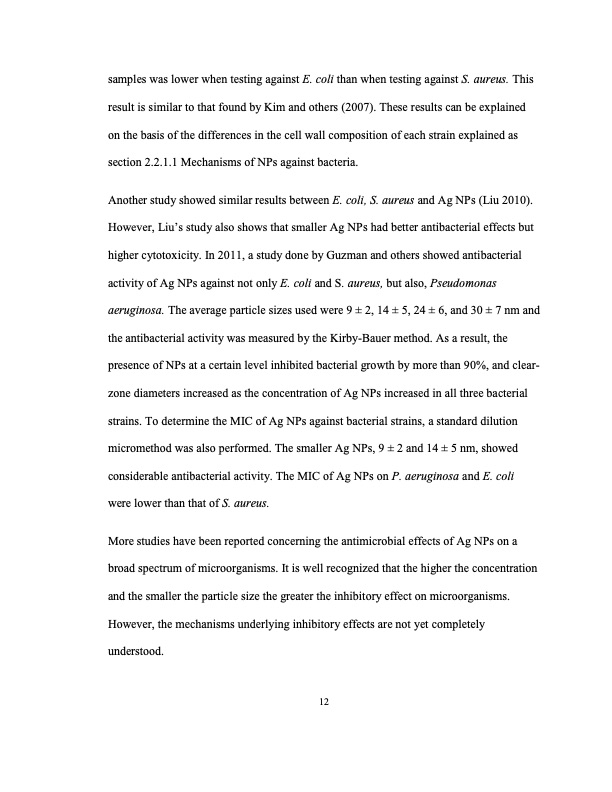
PDF Publication Title:
Text from PDF Page: 023
samples was lower when testing against E. coli than when testing against S. aureus. This result is similar to that found by Kim and others (2007). These results can be explained on the basis of the differences in the cell wall composition of each strain explained as section 2.2.1.1 Mechanisms of NPs against bacteria. Another study showed similar results between E. coli, S. aureus and Ag NPs (Liu 2010). However, Liu’s study also shows that smaller Ag NPs had better antibacterial effects but higher cytotoxicity. In 2011, a study done by Guzman and others showed antibacterial activity of Ag NPs against not only E. coli and S. aureus, but also, Pseudomonas aeruginosa. The average particle sizes used were 9 ± 2, 14 ± 5, 24 ± 6, and 30 ± 7 nm and the antibacterial activity was measured by the Kirby-Bauer method. As a result, the presence of NPs at a certain level inhibited bacterial growth by more than 90%, and clear- zone diameters increased as the concentration of Ag NPs increased in all three bacterial strains. To determine the MIC of Ag NPs against bacterial strains, a standard dilution micromethod was also performed. The smaller Ag NPs, 9 ± 2 and 14 ± 5 nm, showed considerable antibacterial activity. The MIC of Ag NPs on P. aeruginosa and E. coli were lower than that of S. aureus. More studies have been reported concerning the antimicrobial effects of Ag NPs on a broad spectrum of microorganisms. It is well recognized that the higher the concentration and the smaller the particle size the greater the inhibitory effect on microorganisms. However, the mechanisms underlying inhibitory effects are not yet completely understood. 12PDF Image | ZINC OXIDE AND SILVER NANOPARTICLES ON INTESTINAL BACTERIA

PDF Search Title:
ZINC OXIDE AND SILVER NANOPARTICLES ON INTESTINAL BACTERIAOriginal File Name Searched:
thesis-zinc-oxide-silver-nano.pdfDIY PDF Search: Google It | Yahoo | Bing
Turbine and System Plans CAD CAM: Special for this month, any plans are $10,000 for complete Cad/Cam blueprints. License is for one build. Try before you buy a production license. More Info
Waste Heat Power Technology: Organic Rankine Cycle uses waste heat to make electricity, shaft horsepower and cooling. More Info
All Turbine and System Products: Infinity Turbine ORD systems, turbine generator sets, build plans and more to use your waste heat from 30C to 100C. More Info
CO2 Phase Change Demonstrator: CO2 goes supercritical at 30 C. This is a experimental platform which you can use to demonstrate phase change with low heat. Includes integration area for small CO2 turbine, static generator, and more. This can also be used for a GTL Gas to Liquids experimental platform. More Info
Introducing the Infinity Turbine Products Infinity Turbine develops and builds systems for making power from waste heat. It also is working on innovative strategies for storing, making, and deploying energy. More Info
Need Strategy? Use our Consulting and analyst services Infinity Turbine LLC is pleased to announce its consulting and analyst services. We have worked in the renewable energy industry as a researcher, developing sales and markets, along with may inventions and innovations. More Info
Made in USA with Global Energy Millennial Web Engine These pages were made with the Global Energy Web PDF Engine using Filemaker (Claris) software.
Infinity Turbine Developing Spinning Disc Reactor SDR or Spinning Disc Reactors reduce processing time for liquid production of Silver Nanoparticles.
| CONTACT TEL: 608-238-6001 Email: greg@infinityturbine.com | RSS | AMP |